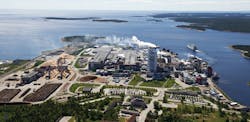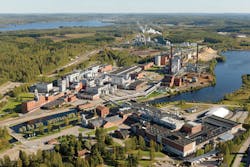By Jeff Gunderson
Rising global water scarcity and increasing competition for water supplies among industrial, municipal, and agricultural uses are placing greater stress on freshwater resources. Like other water-intensive industries that face future water supply challenges, the pulp and paper sector is actively taking steps to address this issue by adopting water conservation programs and more responsible water use practices.
While such efforts are driven by sustainability goals, corporate and environmental responsibility, and long-term water security needs, water management programs in pulp and paper are also increasingly being implemented for financial reasons. Economic factors that may play a part in influencing a decision to pursue a sustainable water management strategy include rising potable water costs, energy consumption, and more stringent discharge requirements.
Kevin Bossy, CEO of Ontario, Canada-based Bishop Water Technologies, an environmentally focused solution provider to industries including pulp and paper, said tighter water quality effluent standards and rising municipal surcharges are incentivizing more Canadian pulp and paper mills located in urban regions to incorporate water efficiency projects, including water recycling, as measures for reducing discharge volumes.
“Increasing pressures on municipal infrastructure systems are causing utilities to assess the true user costs of the sanitary sewer,” Bossy said. “Pulp and paper mills are certainly big users and dischargers of water, and as these facilities contend with higher user fees and more stringent discharge loading requirements, the next logical step is to maximize reuse opportunities for reducing discharges and associated costs.”
From a sustainability perspective, the ability to continually regenerate water and utilize it in operational processes can also help alleviate risks related to escalating raw water costs and especially future supply limitations, according to Bossy.
“One of the benefits for commodity-side businesses that face continual margin pressure is that greater opportunities for sustainability are generally available,” Bossy said. “That’s what we are seeing not only in pulp and paper but in many other industries as well.”
Water Management Strategies Reduce Energy Costs
Finland-based Metsä Board, one of Europe’s leading suppliers of paperboard, was recently awarded a position on the CDP Water A List for a second consecutive year for its actions to manage water more sustainably. The company’s extensive water management program - launched at three pulp mills and six board mills for improving water usage - has resulted in positive impacts on energy and production efficiency.
“Water use at production sites directly affects energy consumption, which in turn influences costs,” said Soili Hietanen, Metsä Board vice president of sustainability and energy. “By minimizing water use, we can lower our energy needs.”
At Metsä Board’s Simpele mill, specific measures that were implemented as part of the company’s overall sustainable water strategy included improvements to paperboard machine heat recovery processes for reducing steam requirements as well as rebuilding the mill’s press section to enhance water removal rates and lower the volume of steam needed for drying the paperboard line. Additionally, automation and pumping technology upgrades that have effectively reduced wastewater volumes have enabled for pulp grinder load adjustments which, in turn, have helped to level out peak loads in the electricity grid.
Metsä Board’s water management efforts also include actions to minimize impacts on surrounding water resources. “Though all our production sites are located in water rich areas, we only use surface water in our operations and avoid taking water from other industrial uses,” Hietanen said. “Additionally, 98 percent of water used in Metsä Board production processes is carefully purified before being discharged to nearby waterways.”
A Conservation Response to California’s Water Crisis
At a high level, the American Forest & Paper Association (AF&PA) supports industry-wide water conservation efforts through its Better Practices, Better Planet 2020 sustainability initiative, which lays out a comprehensive set of sustainability goals for AF&PA members to achieve by the year 2020. With regard to water, AF&PA’s sustainability target is to reduce water use in members’ pulp and paper mills by 12 percent between 2005 and 2020.
Since 2012, AF&PA has recognized achievements in sustainability made by member pulp and paper companies each year through its Sustainability Awards. Last year, Procter & Gamble (P&G) was the recipient of the 2016 AF&PA Leadership Sustainability Award for Water based on a water conservation response project that was implemented at P&G’s Oxnard, Calif., paper mill that led to a 28 percent reduction in cumulative absolute freshwater consumption between 2012 and 2015.
P&G’s water conservation response project was initiated in 2015 after the Governor of the State of California - reacting to the state’s water crisis - issued a mandatory order in February of that year for a non-agricultural, economy-wide 25 percent absolute reduction in freshwater consumption within one year, based on a 2013 baseline period.
For municipal water users within Oxnard, including the paper mill, the Governor’s mandate meant that a 12 percent absolute water reduction was required by February 2016. The Oxnard facility, responding to the mandate, implemented five distinct projects to deliver additional water consumption reductions on top of previously established conservation measures that resulted in an absolute 12.6 percent water reduction, surpassing the target goal.
“California was facing a historic drought, and P&G’s water conservation efforts set new site and business records for low levels of water consumption,” said AF&PA President and CEO Donna Harman. “P&G’s projects included switching from freshwater to treated water sources on the headbox hygiene showers, installing a water-balancing booster pump on a dissolved air flotation system, and implementing on-machine and work process controls for the paper machine startup and shutdown sequence in order to mitigate any overflows from water chests.”
Two further projects focused on making use of recovered water from the gravity table press (which is used as a prethickener to remove water from paper sludge) and from the Yankee area in papermaking (where spray water is used to improve hygiene in the glue box), according to Harman.
“In the papermaking process, water is just as important as wood fiber,” Harman said. “Because it is so important in our members’ manufacturing processes, they continue to innovate ways to reduce, reuse and recycle the water they use.”
Jeff Gunderson is a correspondent for Industrial WaterWorld. He is a professional writer with over 10 years of experience, specializing in areas connected to water, environment and building, including wastewater, stormwater, infrastructure, natural resources, and sustainable design. He holds a master’s degree in environmental science and engineering from the Colorado School of Mines and a bachelor’s degree in general science from the University of Oregon.




